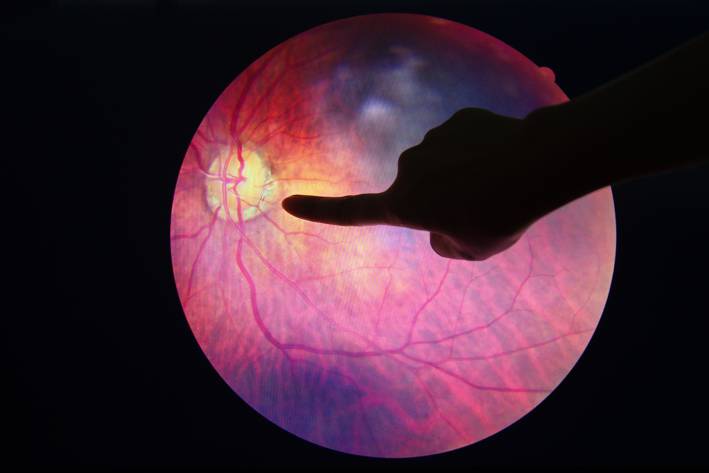Did you ever play games as a kid such as “Would you rather..?”
- Would you rather be attacked by a lion or a bear?
- Would you rather be stranded on a deserted island or lost in the woods?
- Would you rather lose your hearing or your eyesight?
According to surveys (Yes, scientists study everything!), the most common answer is that people would preserve their vision over hearing. Some of the reasons given are that they equate vision with more independence, with driving, with reading, with media, with understanding the world around them.
How sad, then, that millions of Americans are at risk for losing their sight because of a disease that is preventable: diabetic retinopathy.
What is Diabetic Retinopathy?
Diabetic retinopathy is the leading cause of vision damage and vision loss in American adults.
How Common is Diabetic Retinopathy?
It is estimated that about 1 in 3 people with diabetes will develop this problem, though not all will progress to full blindness. The longer a person has diabetes, the longer they do not have good blood sugar control, the greater the risk of this disorder.
What Causes Diabetic Retinopathy?
In 2020, about 35 million Americans had diabetes and 88 million had pre-diabetes. These abnormal blood sugar levels are killing our eyesight!
One way to measure blood sugar health is the hemoglobin A1c test (HbA1c) test. Levels greater than 7.0 are associated with a 3.5 times increase in severity of diabetic retinopathy. It absolutely pays to reduce blood sugar levels to preserve eyesight, and there are many lifestyle changes and natural compounds such as Hintonia latiflora, cinnamon, and berberine that can help with that.
However, the topic of this article is looking at nutrients that directly affect vision.
Recommended Nutrition
These nutrients are well known, but not necessarily well known for preserving vision and addressing retinopathy: curcumin, grape seed extract, melatonin, and propolis.
-
Curcumin
Curcumin is the most powerful herbal anti-inflammatory that I have ever encountered, and it is a potent antioxidant as well. Both functions play a role in preventing the damage that leads to diabetic retinopathy.
In a 2018 study on enhanced-absorption curcumin with turmeric essential oil (BCM-95 Curcumin) demonstrated that 1,500 mg of curcumin daily could significantly reduce a marker of inflammation called the high-sensitivity C-reactive protein (CRP) levels in ten weeks. The hs-CRP test is highly predictive of many diseases, and some researchers have proposed that CRP levels be used as a biomarker to evaluate the severity of diabetic retinopathy. That means that reducing CRP is strongly correlated with reducing eye damage.
Another 2018 study using a curcumin phytosome (Meriva) demonstrated that taking 1,000 mg for three months significantly improved visual acuity in 83 percent of participants with diabetic macular edema, a very common complication of diabetic retinopathy.
The use of curcumin for preservation of eyesight can be highly effective, but the best results occur when curcumin is better absorbed, so look for enhanced-absorption products.
-
Grape Seed Extract
Grape seed extract is a rich source of compounds called polyphenols. One type of polyphenol, called oligomeric proanthocyanidins (OPC), is enormously beneficial for a wide variety of health problems, with studies on cancer, diabetes, hypertension, and liver and cardiovascular diseases.
The same mechanism of action that makes it a powerful natural medicine for all these diseases makes it great for preventing retinopathy and helping to maintain vision in people who already have damaging eye changes.
However, the OPCs that are so beneficial come in a variety of sizes, and not all are absorbable. The largest size OPCs are called tannins and are too big for absorption. It is useful to make sure the grape seed extract you choose is 100 percent absorbable and tannin-free for superior results.
Grape seed extract is also a super-potent antioxidant and has some anti-inflammatory activity as well. One aspect of retinopathy is the collapse and/or clogging of the tiny blood vessels that feed the eye. The OPCs in grape seed extract can protect those tiny vessels. Additionally, grape seed extract has antidiabetic properties.
A 2019 study demonstrated that grape seed extract was superior to a prescription medication used for diabetic retinopathy. Patients received 150 mg grape seed extract or 750 mg of calcium dobesilate per day. At the end of the 12-month study, people in the grape seed extract group had significant improvements in factors related to diabetic retinopathy. Treatment success was highest in the grape seed extract group at 43.9 percent, versus 14.3 percent in the prescription drug group.
-
Melatonin
I know that most folks think of melatonin as a sleep aid, but it is so much more than that. I always think of it as the conductor of a great orchestra. Melatonin sets the rhythm and directs all the instruments to play at certain intervals and with varying levels of intensity.
It influences everything from your blood pressure to how quickly you digest food, so it should not be surprising that it plays a powerful role in eye health, too.
Melatonin is made mainly in the pineal gland in the brain, but it is also synthesized in the retina of the eye to help to protect against oxidative stress and damage.
A clinical study on a retinal disease called central serous chorioretinopathy (CSCR) found that melatonin could improve visual function. Participants were given a placebo or 3 mg of melatonin three times per day. After one-month, 87.5 percent of the participants in the melatonin group
experienced a significant improvement in visual acuity. Additionally, the participants also experienced a reduction in macular thickness, indicating a positive response and decrease in edema in the eye. This is good news for people who already struggle with changes related to retinopathy.
-
Propolis
Another effective natural medicine that can help with diabetic retinopathy is propolis. Propolis is a plant substance collected by bees, then mixed with other bee compounds and deposited in the structure to protect the health of the hive and all its inhabitants. It is potently antiviral and antibacterial but has vision preservation properties as well.
A 2019 research study demonstrated that propolis could help prevent diabetes-associated retinal changes. Propolis was shown to protect the retina in several ways, including reductions in fasting blood sugar, HbA1c, and inflammatory compounds. The researchers showed that propolis also protected the retinal barrier from oxidative changes.
-
Other Nutrients
There are so many other nutrients that are beneficial for vision in general and eye diseases in particular.
- All the carotenoids, especially beta carotene, lutein, and zeaxanthin are useful, as are vitamins such as A, C, and E.
- Bilberry and blueberry contain nutrients that promote healthy vision.
- Ginkgo, often used for memory and brain function, is also beneficial for improving blood flow to the retina.
The list goes on. There is no single natural medicine that does it all, so you may want to consider pulling together a protocol that works best for you.


